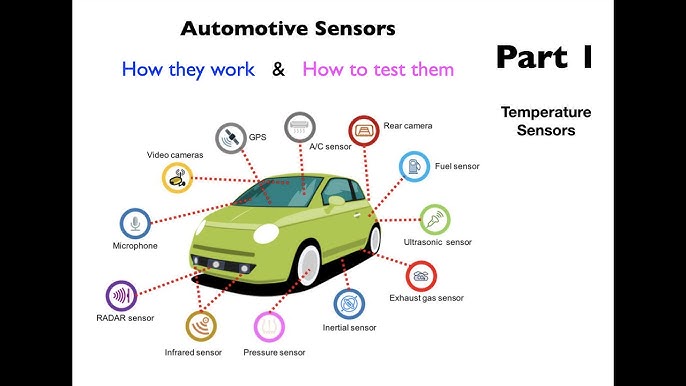
By creckk On 13-09-2025 at 11:50 am
Your Vehicle’s Sensors - How They Work, Testing & Troubleshooting Guide
Why Car Sensors Matter More Than You Think
Imagine driving on a highway, and suddenly your “Check Engine” light comes on. For most of us, that glowing icon sparks panic. But in reality, it’s often your car’s sensors trying to talk to you. These sensors act as the nervous system of your vehicle, constantly measuring and adjusting key parameters like fuel ratio, airflow, and throttle response.

If even one of these sensors malfunctions, it can throw your car’s performance off balance causing poor mileage, misfires, stalling, or even engine damage. That’s why understanding how they work and how to test them is essential, whether you’re a car enthusiast or simply want a trouble-free drive.
Types of Vehicle Sensors and Their Role in Performance
Modern cars rely on multiple sensors, but three of the most crucial ones are:
- Oxygen Sensor (O2 Sensor): Reads unused oxygen in exhaust gases to balance the air-fuel mixture.
- Mass Air Flow Sensor (MAF): Measures air volume and density entering the engine, helping optimize ignition timing and fuel delivery.
- Parking Sensor (PS) : Parking sensors use ultrasonic waves to detect nearby obstacles while reversing, alerting you with beeps or visuals. To test, shift to reverse and check if the beeps respond to objects; if not, clean or replace the sensor.
- Throttle Position Sensor (TPS): Tracks accelerator pedal and throttle plate movement to inform the ECU how much power the driver demands.
Oxygen Sensor – Working and Testing
The oxygen sensor ensures your car burns fuel efficiently by maintaining the correct air-fuel ratio. It is usually located in the exhaust manifold or pipe.
How to Test:
- Check for worn insulation or loose wiring connections.
- Warm up the engine for 5 minutes, then switch it off.
- Connect a Digital Volt Ohm Meter (DVOM) to the sensor’s connector.
- Restart the engine readings should fluctuate between 100 and 1,000 mV (0.1–1.0V).
- If readings don’t fluctuate, the oxygen sensor is faulty and must be replaced.
Tip: After replacement, clear the ECU memory by disconnecting the negative battery cable for at least 10 seconds.
Throttle Position Sensor (TPS) – Working and Testing
The TPS is located on the carburetor or fuel injector and informs the ECU about throttle position. A faulty TPS can cause jerky acceleration, poor idling, or misfires.
How to Test:
- Inspect for damaged wiring or cracked connectors.
- Use a DVOM in 20K ohm mode connect the leads to the central and side terminals.
- Slowly move the throttle from idle to wide-open position.
- The reading should increase or decrease steadily. If not, the TPS is defective.
- Reconnect and clear ECU codes by disconnecting the battery.
Mass Air Flow (MAF) Sensor Working and Testing
The MAF sensor sits between the air filter and the throttle body. It helps calculate fuel injection timing and engine load. A faulty MAF can lead to stalling, rough idling, or poor fuel efficiency.
How to Test:
- Start the engine and gently tap the sensor with a screwdriver handle.
- If the engine stutters, misfires, or stalls, the sensor is defective.
- Replace the faulty sensor and reset ECU error codes by disconnecting the battery.
Why Choosing the Right Sensors Matters
Not all sensors are created equal. Cheap aftermarket sensors may fail early or send incorrect readings, leading to expensive engine damage. For reliable replacements, always choose high-quality sensors tested for your specific car model.
At Creckk, you’ll find a wide range of genuine automotive sensors from O2 to MAF and TPS designed to work seamlessly with your vehicle’s system. Each product is carefully tested to ensure durability, accuracy, and safety.
Final Thoughts: Healthy Sensors, Healthy Car
Your car’s sensors may be small, but their role is massive. From fuel efficiency to smooth driving, they keep everything in check. The good news is testing them doesn’t require a huge workshop. With basic tools and the right guidance, you can diagnose issues early and prevent major repair bills.
And when it’s time to replace, trust only quality sensors from reliable sources like Creckk. After all, your car deserves the same care you’d give to its engine or tires—because without healthy sensors, the engine is driving blind.
FAQs:
What are the main sensors in a car?
Three of the most important sensors are Oxygen (O2), Mass Air Flow (MAF), Parking Sensor (PS) and Throttle Position Sensor (TPS). They regulate air-fuel ratio, airflow, and throttle control.
How do I know if my oxygen sensor is bad?
If the DVOM reading doesn’t fluctuate between 100–1,000 mV, the O2 sensor is faulty. Symptoms include poor mileage, engine misfires, and a glowing check engine light.
What are the symptoms of a bad TPS?
Jerky acceleration, irregular idle, poor throttle response, and error codes in the ECU indicate a failing TPS.
Can a faulty MAF sensor damage my car?
Yes. A faulty MAF can cause the ECU to inject the wrong fuel amount, leading to rough running, stalling, or long-term engine wear.
Where can I buy genuine car sensors in India?
You can buy high-quality, reliable car sensors for all major brands at Creckk, ensuring compatibility, warranty, and professional installation support.
Related posts









